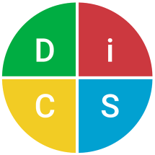Improve communication and performance with DiSC
Improve communication, productivity, and teamwork in the workplace using DiSC

DiSC is a personal assessment tool that is widely used to improve communication, productivity, and teamwork in the workplace. DiSC stands for Dominance, Influence, Steadiness, and Conscientiousness, and it measures an individual’s behavioural preferences and tendencies. The assessment is based on the work of psychologist William Moulton Marston and was later developed into the DiSC assessment tool by Walter Vernon Clarke in the 1950s. It is highly effective in developing personal communication styles in high performance teams.
The benefits of DiSC are many, and they can be experienced both at the individual and organizational level. Here are some of the most significant benefits of DiSC:
- Improved Communication: Communication is critical to success in any workplace, and DiSC helps individuals understand their communication styles and preferences. The assessment provides insight into how individuals prefer to communicate and interact with others. It helps individuals understand their strengths and weaknesses and how they can better communicate with others. This understanding leads to more effective and efficient communication, which can reduce misunderstandings, conflicts, and errors.
- Increased Self-awareness: DiSC assessment helps individuals gain a better understanding of themselves, their personality, and their behavioural tendencies. This self-awareness helps individuals recognize their strengths and weaknesses, which in turn helps them improve their performance and make better decisions. Self-awareness also helps individuals understand how they can be more effective in their roles, which can lead to improved job satisfaction and productivity.
- Enhanced Teamwork: DiSC helps team members understand each other’s behavioural tendencies and communication styles. This understanding can help individuals work better together, leverage each other’s strengths, and minimize conflicts. By recognizing and respecting different communication styles, team members can build more effective relationships, leading to improved teamwork, collaboration, and productivity.
- Improved Leadership: DiSC can help leaders understand their leadership style, strengths, and weaknesses. Leaders can use this information to improve their communication with their team members and tailor their leadership approach to different personalities. By recognizing and adapting to different behavioural styles, leaders can create a more inclusive and effective work environment.
- Increased Productivity: DiSC helps individuals and teams work more efficiently and effectively. By improving communication, reducing conflicts, and enhancing teamwork, individuals can focus on their work and deliver better results. By understanding and leveraging each other’s strengths, teams can complete tasks faster, more accurately, and with less stress.
DiSC is a popular model used for understanding behaviour and communication styles in various settings, including workplaces, teams, and interpersonal relationships. DiSC is an acronym that stands for Dominance, Influence, Steadiness, and Conscientiousness, and each element has its own unique attributes. Here’s a brief overview of the main attributes associated with each DiSC element:
- Dominance (D): People with a dominant style tend to be assertive, results-oriented, and direct in their communication. They may be seen as confident, decisive, and competitive. They are often focused on achieving goals and may prefer taking charge and leading others.
- Influence (I): Individuals with an influential style are usually outgoing, expressive, and social. They are often seen as optimistic, energetic, and persuasive. They enjoy building relationships, networking, and influencing others. They may be skilled at motivating and inspiring those around them.
- Steadiness (S): People with a steady style are typically cooperative, patient, and reliable. They are often viewed as calm, supportive, and diplomatic. They prefer stability and harmony in their environment and relationships and may excel at building and maintaining strong, long-term connections with others.
- Conscientiousness (C): Those with a conscientious style are usually analytical, detail-oriented, and cautious. They are often seen as precise, systematic, and thorough. They value accuracy and quality and may be diligent in following rules and procedures. They are often well-organized and strive for excellence in their work.
It’s important to note that individuals may exhibit a blend of different DiSC styles and that DiSC is just one model among many that can be used to understand human behaviour. People are complex and multidimensional, and behaviour can vary depending on the situation and context. DiSC is a tool that can provide insights into communication styles and preferences, but it’s not a definitive or comprehensive measure of an individual’s personality or abilities.
In conclusion, DiSC is a valuable tool for improving workplace communication, productivity, and teamwork. It provides individuals with insight into their behavioural tendencies and helps them understand how to communicate effectively with others. The assessment helps individuals become more self-aware, which can lead to improved job satisfaction and performance. DiSC also enhances teamwork, improves leadership, and increases productivity. With these benefits, it’s no wonder that DiSC is widely used by organizations of all sizes and industries to improve their workplace dynamics.
